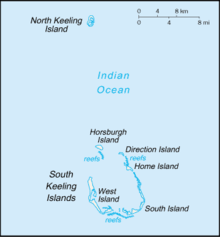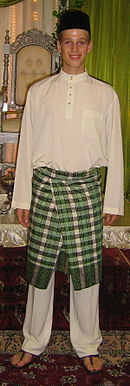Coconut Malays
The Cocos Malays , German: coconut Malays (including Cocos Malay people called), form an ethnic group , relying on the Cocos Islands to its appropriation developed by Europeans and by them as slaves had been deported there. These people speak their own Malay dialect , have their own prayer houses , guides and their own culture.
history
When Captain William Keeling reached the Cocos Islands in 1609, they were uninhabited. In 1825 John Clunies-Ross , the ship's captain of Alexander Hare , came to the still uninhabited islands for the first time. First, Alexander Hare, a businessman and slave trader, settled there in 1826 with 100 Malays and his harem . On the islands coconut palms were planted by the Cocos Malays and made from them copra and coconut oil . The first people to come to the islands with Hare were mostly Malays , including some Chinese, Papuans and Indians. But it is also believed that among the first settlers were people from Bali , Celebes , Madura , Sumbawa , Sumatra , Timor , Pasir Gudang , Malacca , Penang , Batavia and Cirebon . Clunies-Ross settled on Home Island with 40 Malay in 1827 and installed a slave-like social and political system, which Charles Darwin qualified as follows after his stay in the Cocos Islands in 1836:
"The Malays are in a state of freedom by name, but they are considered slaves."
On December 22, 1837, there was an unsuccessful revolt by the Malays against this system of total dependency and low pay. As a result, the Scottish John Clunies-Ross, who called himself King Ross I, pushed through an agreement that forced the Malay , Bantamese and European families living on the Cocos Islands to live in his homes and work for him or to leave the island .
The Cocos Malays , who lived isolated from the outside world, separated themselves from the Europeans and kept their own identity for eight generations.
After the Second World War, many Cocos Malays emigrated, especially to Singapore and Sabah (then North Borneo ), Malaysia. At the end of the 20th century, unemployment among islanders was very high in 2009 at an estimated 65%. Since there were also disputes over the language of the islanders, the Australian Interior Minister Brendan O'Connor traveled to the islands in September 2009, where the language problem and high unemployment were discussed at various crisis meetings. The construction of a tourist center for Muslims from the Pacific region, which will create 79 jobs, is expected to ease the labor market .
present
In 2000 there were around 5000 Cocos Malays worldwide, most of them in Tawau and Lahad Datu , North Borneo. In Malaysia, the number of Cocos Malays is almost ten times that of the Cocos Islands. The Cocos Malays represent a rural population, they live in villages in so-called Kampungs , mainly in Bantam on Home Island ; most of them are farmers who also catch fish. Home Island is in an isolated and remote location from the mainland, about 2100 km from mainland Australia and about 1000 km from Sumatra and Java and 900 km from Christmas Island .
Over 80% of the Cocos Malays are followers of the Sunni faith, a Muslim religion, and they mostly live on Home Island. Marriage is important according to Muslim beliefs and you can have up to four wives, but this is rarely common. At the end of Ramadan they hold a celebration, the Hari Raya Puasi . For example, there is a house of prayer for their religious practice, the West Island Mosque on West Island .
Cocos Malays speak their own dialect, which is called Basa Pulu Kokos or Bahasa Cocos . It is a dialect of a mixture of Malay and Indonesian languages with English and Scottish language elements . About 450 Cocos Malays speak this dialect . Malay and English are taught in the school.
The Cocos Malays wear special clothing, the Baju Kebaya , which women wear, and men the Baju Melayu or sarong . These Baju Kebaya and Baju Melayu dresses are typical of Malay ethnic groups. Several of their dances are influenced by Javanese and British cultures. You will eat typical Malay dishes, which are prepared with rice, noodles, curry, chilli, chicken, beef and lamb as well as fruits of the sea. They also adhere to Ramadan. There are three restaurants on Home Island , one of which serves Western fare. The fresh water is limited and rainwater is collected.
Individual evidence
- ^ A b rulers.org : Clunies-Ross Dynasty, in English, accessed on September 16, 2011
- ↑ a b c worldmap.org ( Memento of the original from December 25, 2013 in the Internet Archive ) Info: The archive link was inserted automatically and has not yet been checked. Please check the original and archive link according to the instructions and then remove this notice. (PDF; 134 kB): Mission Atlas Project, p. 2, in English, accessed on September 16, 2011
- ↑ environment.gov.au
- ↑ a b theaustralian.com.au : Paige Taylor: Administrator to head Cocos Islands , September 1, 2009, in English, accessed September 16, 2011
- ↑ a b intellaisa.net ( page no longer available , search in web archives ) Info: The link was automatically marked as defective. Please check the link according to the instructions and then remove this notice. : Cocos Malays fight Aust ban on dialect , in English, accessed September 16, 2011
- ↑ Archived copy ( Memento of the original from May 14, 2014 in the Internet Archive ) Info: The archive link was inserted automatically and has not yet been checked. Please check the original and archive link according to the instructions and then remove this notice.
- ↑ bahasa-malaysia-simle-fun ( memento of the original from September 3, 2011 in the Internet Archive ) Info: The archive link was automatically inserted and not yet checked. Please check the original and archive link according to the instructions and then remove this notice. : Do You Speak Bahasa Malaysia the Sabah Version? , in English, accessed September 16, 2011

